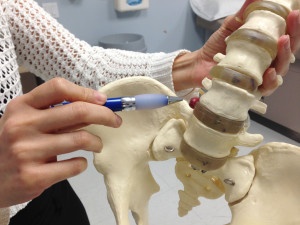 If you have minor to intense lower back pain, then you may suffer from a condition known as Degenerative Disc Disease. This condition affects people throughout the world, and there are a number of mitigating factors that lead to its development, with aging at the top of the list. We’d like to help you understand this condition and what can be done to help you heal.
If you have minor to intense lower back pain, then you may suffer from a condition known as Degenerative Disc Disease. This condition affects people throughout the world, and there are a number of mitigating factors that lead to its development, with aging at the top of the list. We’d like to help you understand this condition and what can be done to help you heal.
[separator headline="h3" title="What Does Having Degenerative Disc Disease Even Mean?"]
Degenerative Disc Disease is a condition affecting the intervertebral discs that act as cushions between the vertebrae that make up the spine. Over the course of time, it’s actually possible for these discs to become dehydrated, with certain actions exacerbating this lack of fluid.
When dehydration takes place, the exterior portion of the disc known as the annulus can suffer tears, and this is where the individual will begin to experience fallout in the form of back pain. At this juncture, pain and slight inflammation are to be expected.
The discs themselves can also thin out when they’re not properly hydrated. Imagine a sandwich cookie where the cookie portions are the vertebrae and the cream filling is the disc. Now, picture this filling being sucked out of the cookie, its size being gradually reduced in the process. Notice how the two cookies march inexorably closer together?
The same thing happens with your spine when the discs are thinned out: the vertebrae draw closer to one another, putting pressure on the facet joints that attach a vertebrae to those above and below it. As these joints begin to rub excessively, bone spurs can form, forcing their way into the nerve-filled spinal cord, leading to severe pain, tingling, and numbness that works its way to your lower extremities.
[separator headline="h3" title="Many Surgical and Non-Surgical Options"]
 If a doctor comes to the conclusion that you suffer from Degenerative Disc Disease, you have a few options. Most people want to explore non-surgical methods first. A couple months of physical therapy that includes stretching, stability exercises, and strength training can lead to a reduction in pain. DISC recommends the therapeutic benefits of the Med-X specific spinal strengthening program. Oftentimes, success can be achieved with this therapy in conjunction with corticosteroid injections to treat pain. Advanced interventional pain management procedures including injections of this type are performed on a routine basis, at the DISC outpatient surgery center. This relatively painless procedure helps patients overcome the initial pain and stiffness associated with degenerative disc disease and helps patients to participate in strengthening and rehabilitative activities.
If a doctor comes to the conclusion that you suffer from Degenerative Disc Disease, you have a few options. Most people want to explore non-surgical methods first. A couple months of physical therapy that includes stretching, stability exercises, and strength training can lead to a reduction in pain. DISC recommends the therapeutic benefits of the Med-X specific spinal strengthening program. Oftentimes, success can be achieved with this therapy in conjunction with corticosteroid injections to treat pain. Advanced interventional pain management procedures including injections of this type are performed on a routine basis, at the DISC outpatient surgery center. This relatively painless procedure helps patients overcome the initial pain and stiffness associated with degenerative disc disease and helps patients to participate in strengthening and rehabilitative activities.
Surgical options may also be considered. In cases where the disc presses on the spinal cord, a microdiscectomy can be carried out to remove the damaged area and provide pain relief. A laminectomy accompanies this operation as a means of gaining access to the disc in question, as it involves removing the bony protection surrounding the disc. It therefore helps not to think of things as microdiscectomy vs laminectomy, as the two can work in conjunction with one another. The minimally invasive spine surgeons at DISC perform these procedures on an outpatient basis. Patients typically return home the same day of surgery and experience rapid recoveries. Surgeons at DISC operate in the cleanest possible conditions with the most advanced tools and techniques available. This combination of utmost expertise with top notch facilities allows DISC to maintain a 0% MRSA infection rating and 97% positive patient satisfaction rating.
Depending upon the specifics of an individual’s condition, other surgical options could include a facetectomy for the removal of bone spurs or one of a variety of fusion operations designed to lock each vertebrae in place, preventing the type of gradual movement that produces pain. DISC surgeons also perform these procedures on an outpatient basis, with minimal scarring and disruption to surrounding tissue.
Exploring these options is essential for any individual who suffers from Degenerative Disc Disease.
About the author




